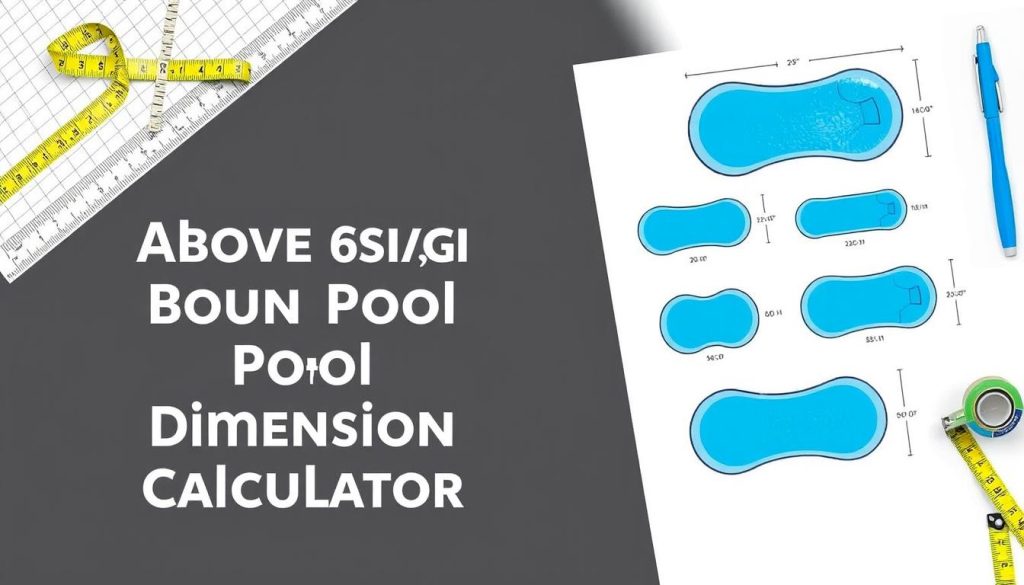
Above ground pools offer more swimming space at a lower cost. Accurate measurements are vital for a perfect replacement liner fit. This ensures your pool’s optimal performance.
Proper sizing is key to maintaining your backyard oasis. Let’s explore how to measure your pool correctly.
Our guide covers measuring round, oval, and rectangular above ground pools. You’ll learn essential techniques for calculating pool dimensions and capacity.
Follow our easy steps to choose the right liner size. This will help you enjoy seamless swimming all summer long.
Understanding Above Ground Pool Shapes and Sizes
Choosing an above ground pool requires careful consideration of shapes and sizes. Round, oval, and rectangular are the most common shapes. Each shape has its own benefits for different yard sizes and preferences.
Knowing the sizes for each shape is key for accurate above ground pool volume calculation. It also ensures a smooth installation process. Let’s explore the options available to find your perfect pool.

Common Round Pool Sizes
Round above ground pools are a popular choice for homeowners. They’re affordable and easy to install. These pools come in various sizes to fit different yards and budgets.
- 18′ diameter
- 21′ diameter
- 24′ diameter
- 27′ diameter
- 30′ diameter
- 33′ diameter
When estimating above ground pool gallons, consider this fact: A 27′ round pool holds about 5,000 more gallons than a 15’x30′ oval pool. This info helps with water management and chemical balancing.
Popular Oval Pool Dimensions
Oval above ground pools are great for narrow or oddly shaped yards. They offer more swimming space than round pools while fitting into tighter areas. Some popular oval pool sizes are:
- 12’x24′
- 15’x30′
- 18’x33′
When looking at above ground pool measurement tips, remember to account for the support structure. Oval pools need extra space for buttresses.
Wilbar offers buttress-free systems for oval pools. These take up less yard space and need less digging during installation.
Rectangular Pool Options
Rectangular above ground pools are less common but offer a classic look. They’re perfect for those wanting a traditional swimming experience. These pools can also be part of a larger deck or patio area.
While not as widely available, some manufacturers offer custom sizes for rectangular pools. This allows you to meet your specific needs and preferences.
| Shape | Common Sizes | Popularity |
|---|---|---|
| Round | 18′ to 33′ diameter | Most popular, with 24′ being the most common |
| Oval | 12’x24′, 15’x30′, 18’x33′ | 15’x30′ is the most popular oval size |
| Rectangular | Custom sizes available | Less common, but offers a classic look |
Knowing the shapes and sizes of above ground pools helps you make smart choices. Use accurate pool sizing instructions and above ground pool dimensions calculators for the best results.
These tools ensure a smooth installation process and optimal pool performance. With the right information, you’ll find the perfect pool for your backyard oasis.
Step-by-Step Guide: How to Measure an Above Ground Pool
Accurate pool measurements are vital for ordering the right liner size. This guide will help you determine your pool’s dimensions based on its shape. You’ll learn simple techniques to ensure a perfect fit for your new liner.
Measuring Round Pools
For round pools, measure the diameter from wall to wall at two points. Take measurements at 12 and 6 o’clock, then at 3 and 9 o’clock. Use the larger measurement if they differ.
Common round pool sizes include:
- 12′ round
- 15′ round
- 18′ round
- 21′ round
- 24′ round
- 27′ round
- 30′ round
- 33′ round
Determining Oval Pool Dimensions
Oval pools require two measurements: length and width. Measure length at 12 and 6 o’clock, and width at 3 and 9 o’clock. Choose the larger dimensions if measurements vary slightly.
Popular oval pool sizes include:
- 12’x18′ oval
- 12’x24′ oval
- 15’x30′ oval
- 16’x32′ oval
- 18’x33′ oval
Calculating Rectangular Pool Sizes
For rectangular pools, measure length and width from wall to wall at each side’s center. If corners are rounded, measure to the curve’s start.
Common rectangular pool sizes include:
| Length (feet) | Width (feet) |
|---|---|
| 12 | 20 |
| 12 | 24 |
| 16 | 32 |
Measuring Pool Wall Height
Pool wall height determines liner depth. Most above ground pools have heights of 48 to 54 inches. Measure from the wall’s top to the bottom track.
Standard liner depths are 48, 52, and 54 inches. A 1-2 inch difference won’t cause major issues. Always double-check your measurements for the best fit.
Conclusion
Measuring your above ground pool is vital for choosing the right liner size and maintaining proper water capacity. Many customers order the wrong-sized pool cover due to miscalculations. Understanding your pool’s shape helps make informed decisions when selecting a cover or liner.
Our guide walks you through measuring round, oval, and rectangular pools, as well as determining pool wall height. Consider top rail width, water level drop, and non-removable obstacles when taking measurements. Round up to the nearest standard size if your measurements result in a non-standard cover size.
Accurate pool measurements are crucial for calculating volume and determining chemical dosages. They also help in selecting the right filter and pump size. Use the provided formulas and our calculator to compute your pool’s volume based on its dimensions.
With this knowledge, you can confidently maintain your above ground pool. Enjoy a safe, clean, and inviting swimming environment for years to come.







